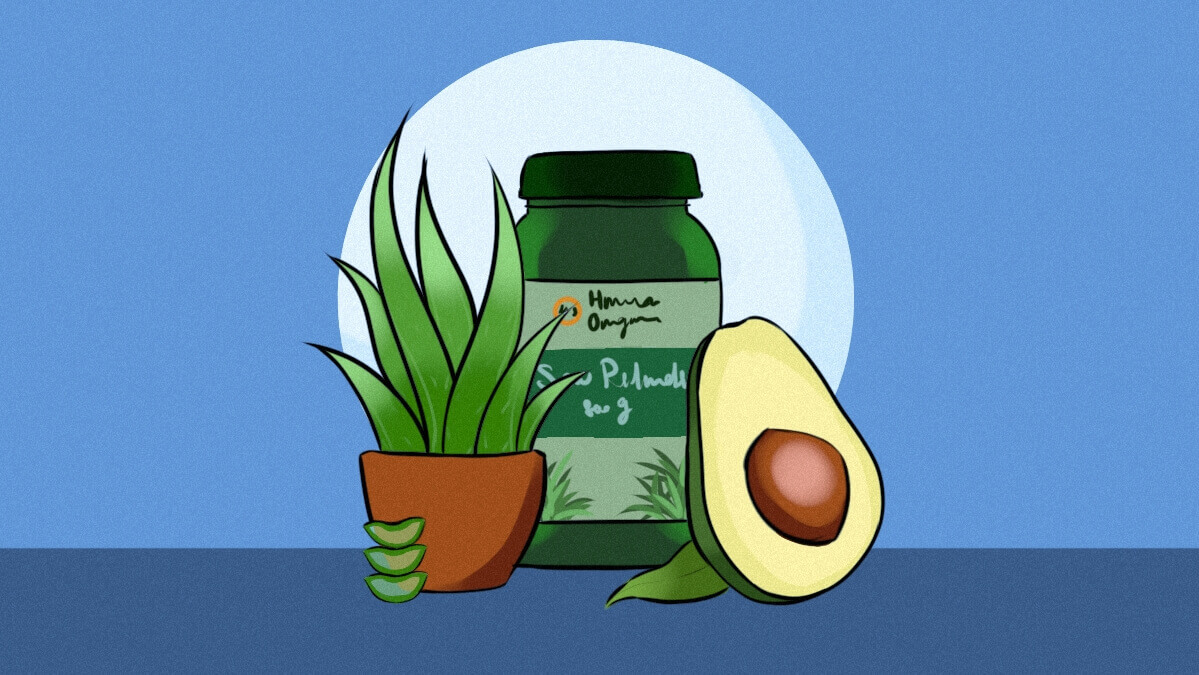TL;DR
➡ Top alternatives to Finasteride for treating hair loss are hair transplants, stem cell injections, minoxidil and PRP injections.
➡ Finasteride’s alternatives do not have the same effect on stopping male pattern baldness as Finasteride. Only Finasteride is a long-term way to block the production of DHT.
➡ Avodart dutasteride, tamsulosin, and tadalafil are alternatives to Finasteride for treating benign prostatic hyperplasia (BPH).
➡ Some natural remedies and practices to use with or instead of Finasteride are derma stamps, aloe vera and scalp massages
In 2022, if you’re searching for an option to fight your hair loss, the best option you have is, without a doubt, Finasteride.
However, when you search for Finasteride on the internet, the first thing to pop up will be its side effects. Although very rare – 7/10000 or 0,0007 – finasteride has possible side effects, mainly affecting testosterone or testosterone byproduct-related mechanisms.
Ultimately, when these factors are tested, some patients wonder if there are alternatives to this medication they can compare before deciding which option to take.
In this article, I will go through all of these options one by one, describe them and explain how they are applied or how effective they are when I compare them to Finasteride:
Table of Contents
Finasteride Alternatives for Hair Loss 💊
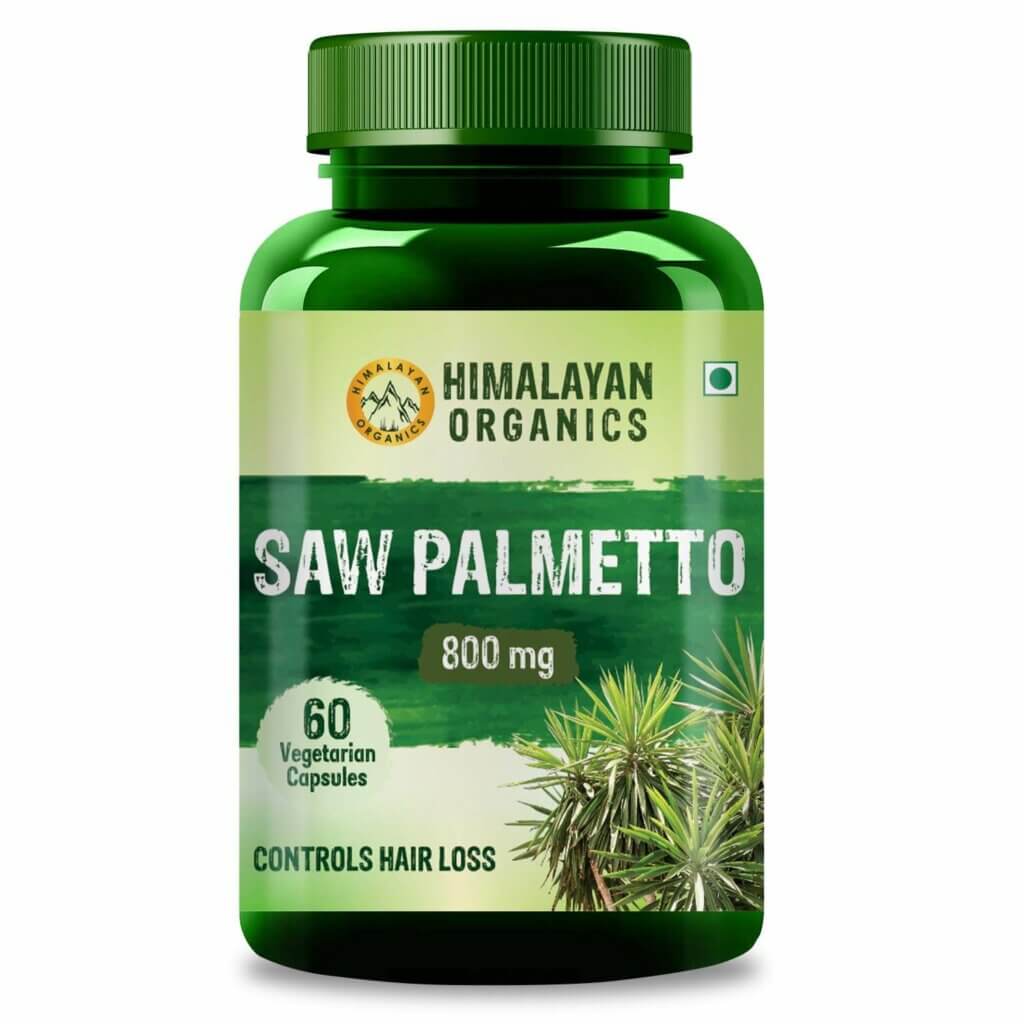
Finasteride’s most meaningful use is treating hair loss as a medication, which it does under its brand name Propecia. So, I will first go through all your medical alternatives for battling hair loss.
Before I Begin, You Have to Know
No alternative on this blog is a direct replacement for finasteride.
Finasteride addresses the source of hair loss by inhibiting the production of dihydrotestosterone (DHT), a hormone that adversely affects your hair follicle health which makes it eventually fall out.
All alternatives I mention on this list promote hair growth and follicle health without addressing the effects of DHT, except for hair transplant surgeries that use your DHT-resistant donor hair to rebuild your hairline.
Most alternatives will be helpful if your hair transplant isn’t caused by male pattern baldness. If not, even if they slow down hair loss, they will not stop it permanently.
1- Hair Transplants
Usually, when a patient experiences hair loss, they are faced with two options based on how much their hair loss has progressed.
If a patient’s hair has just started to fall out recently, supporting medications such as Finasteride are sufficient to slow down and completely prevent this process from progressing. But if hair loss has advanced enough to create balding areas or uneven hairlines, hair transplants become a viable option.
A hair transplant is a surgical process in which tissues containing hairs (called hair grafts) are extracted from one part of your scalp that still has hair, which I call the donor area, to be implanted into a balding area.
The primary point of a hair transplant is that the patient requires some amount of healthy and sufficient hair left in their head to be implanted. In other words, the process focuses on treating bald areas with healthy areas that still have hair, so some hair follicles (the roots from which your hair grows) are required.
Although hair transplants have the same essential focus, they can differ from one another in their technique since modern hair transplant options that we use today contain a 200-year-old history to back it up.
These hair transplant methods contain many varieties based on your scalp’s condition and preference.
According to a clinical study, relying on any hair transplant alone shows a growth improvement rate of 64%, but a hair transplant with Finasteride has a rate of 94%.
Effects of finasteride (1 mg) on hair transplant
Furthermore, a hair transplant alone does not guarantee you will not experience further hair loss from other parts of your scalp in the future. Untouched DHT sensitive hairs may continue falling out.
So, to achieve great-looking and sustainable hair, you shouldn’t rely on either option alone.
Pros of hair transplant surgeries as a Finasteride alternative
- They’re permanent: Hair follicles implanted during hair transplant surgeries remain permanently because they’re harvested from safe donor areas.
- Natural appearance: Transplanted hairs blend with existing hair, providing a natural look.
- No reliance on medication: Hair transplant surgeries do not require ongoing medication, reducing potential side effects and long-term costs.
Cons of hair transplant surgeries as a Finasteride alternative
- Invasive procedure: Hair transplant surgeries are invasive, involving potential risks and complications such as infection, scarring, or poor graft survival.
- Initial Cost: Hair transplant surgeries can be expensive, with costs ranging from a few thousand to tens of thousands of dollars. Finasteride usage over the years can reach the same amount, but the upfront cost of hair transplants can be a downside.
- Recovery time: Post-surgery recovery can take several weeks, with possible limitations on daily activities.
- Multiple sessions: Based on the latest hair transplant statistics, 32.8% of all hair transplant patients needed multiple surgeries for their desired results. So, you might end up needing another surgery.
UnitedCare’s approach
At UnitedCare, we focus on the best option determined for your unique case. Generally, we suggest using Finasteride before and after a hair transplant. As studies show, combining these options increases the success rate of a hair transplant and ensures that you will not experience any further hair loss.
However, if you don’t want Finasteride, that’s still ok, and great results can still be achieved, as shown in the photos below 👇
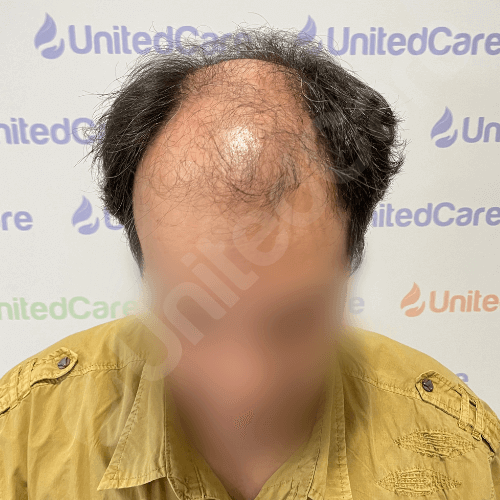
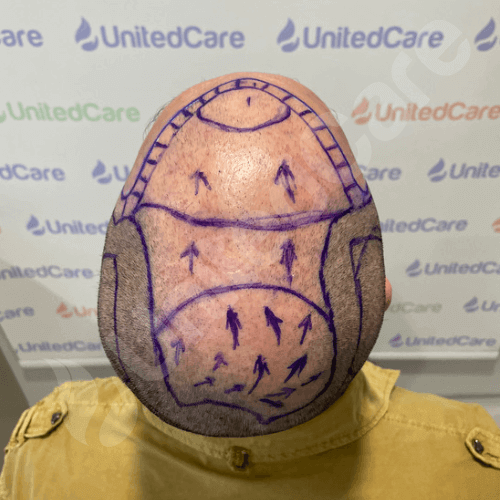
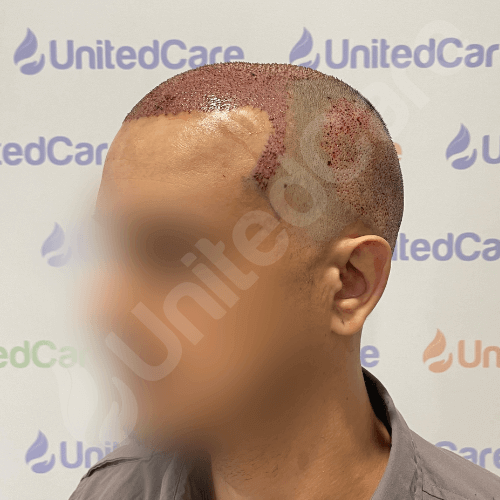
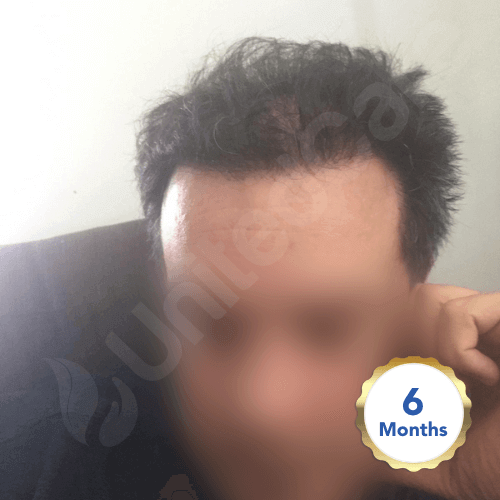
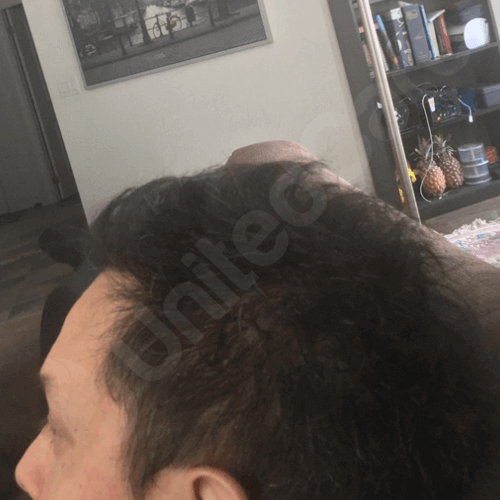
PS: His hair density will continue increasing for 12 more months, and only at the end of 18 months the final result can be monitored.
Deciding on a medical option that will affect your future can be difficult, so we offer you and all our patients a free consultation with all the modern hair transplant methods available.
Our difference is that for any of your preferences, each latest techniques and equipment are available, with all clinically proven supporting medications to offer after a hair transplant provided by an experienced team of dermatosurgeons at an affordable price for your budget.
Turn years back with Finasteride and our hair transplant surgeries.
Restore your natural look with UnitedCare‘s expert dermatologists:
2- Minoxidil
The most famous and prominent alternative medication we have today for Finasteride is, without a doubt, Minoxidil. And like Finasteride, you can also use this medication with or without a hair transplant.
Usually appearing under the brand name Rogaine, Minoxidil is a popular FDA-approved medication for treating male pattern baldness. After being invented in the 1960s by Upjohn, it found its way to the markets as a hair loss medication in 1979 by Dr. Guinter Kahn. And now, it is an easily accessible over-the-counter topical medication.
The use of this medication can appear in three different versions:
- Oral medication you can get with a prescription.
- Topical foam for easy application on your scalp.
- Topical liquid solution.
For best results, I suggest you apply the topical liquid solution half a cap to your scalp twice daily.
However, the principle behind Minoxidil’s effectiveness in dealing with hair loss stays the same. It boosts hair growth by increasing the blood flow to your scalp, which results in thicker hair and healthier follicles. So, it does not grow new hair follicles; it simply increases the amount of blood flow to your scalp, positively affecting your hair’s health.
But beware, Minoxidil is not a one-time solution, meaning that you will have to continue using it to maintain its benefits, and those effects will not appear after a single night. As for its effectiveness, a study shows that 62% of the 984 men using Rogaine Minoxidil report a reduction in hair loss.
❗ But this medication does not come without some possible side effects. The most common ones include scalp sensitivity, skin dryness, irritation around the application site, and increased heart rate.
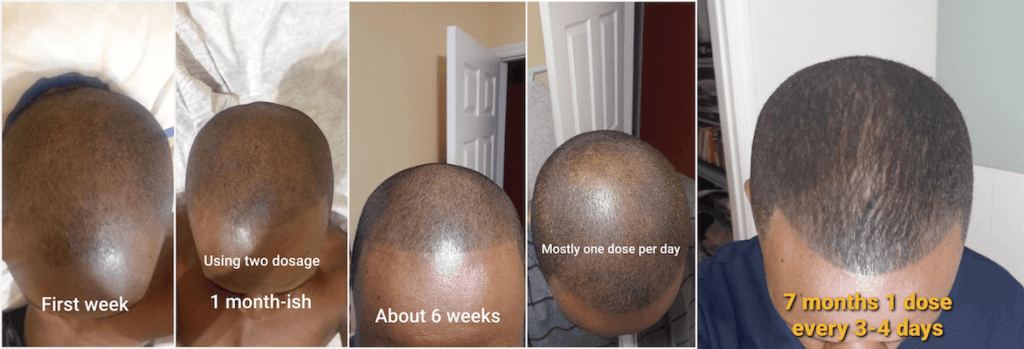
Pros of Minoxidil as a Finasteride alternative
- Non-invasive: Minoxidil is a topical medication, making it a non-invasive treatment for hair loss.
- Over-the-counter: Minoxidil is available without a prescription, providing easier access for users.
- FDA-approved: Minoxidil is an FDA-approved treatment for hair loss in both men and women, indicating its safety and effectiveness.
- May encourage regrowth: Minoxidil can help stimulate hair regrowth and slow down hair loss.
Cons of Minoxidil as a Finasteride alternative
- Continuous usage: Minoxidil must be applied regularly to maintain its effects; once stopped, hair loss may resume.
- Varying effectiveness: The effectiveness of minoxidil varies among individuals, and some may not see significant improvement.
- Application process: Minoxidil requires daily application, which can be time-consuming and inconvenient.
- Side effects: Although uncommon, some users may experience side effects such as scalp irritation, itching, or unwanted hair growth in nearby areas.
3- PRP Treatment
Platelet-Rich Plasma (PRP) is a type of healing technique in which a patient’s body is a part of the healing process.
First, a low amount of the patient’s blood is drawn from their body, and then the platelets in their blood are separated to be later injected into their scalp.
In other words, this treatment does not contain any external source of chemicals to be injected.
Although this treatment has only started being used for treating hair loss in the last two decades, its history goes back to the 1970s. In its early times, this medication was used by hematologists (doctors specializing in blood-related studies and disorders) to treat blood disorders.
Later, around the 1980s, doctors discovered its ability to act as a supporting healing. And finally, when orthopedists started using PRP’s healing and growth factors for treating sports injuries in athletes, it attracted the media’s attention to become more widespread.
The most obvious proof of PRP’s effectiveness was the improved recovery time in well-known athletes of the time, which led to the beginning of studies about it.
Existing studies show promising progress in the PRP treatment’s effectiveness for treating hair loss. However, the downside of this method is that an expert dermatologist is needed for the surgery’s long injection process. And although this is an FDA-approved method, it too comes with specific side effects such as pain, bleeding and burning around the injected area, scalp numbness, and infections.
That is why I suggest that every patient considering a PRP treatment should consult with a clinic that has an expert dermatologist on their staff.
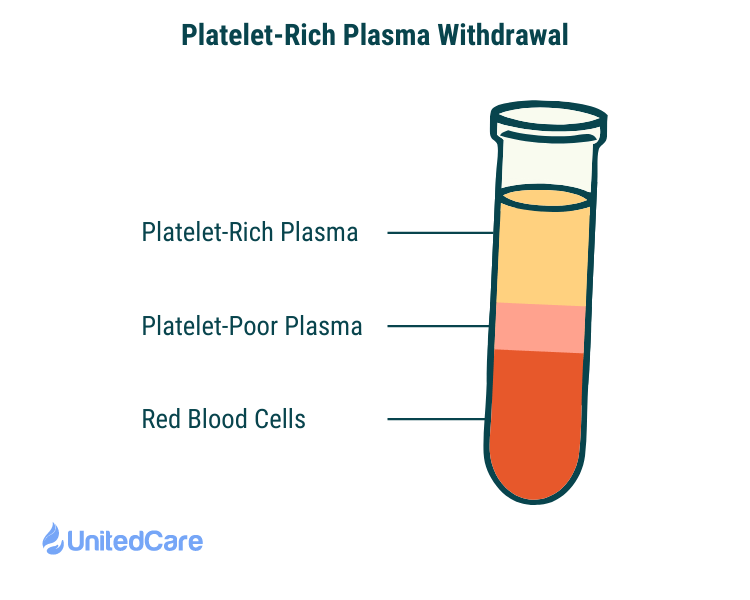
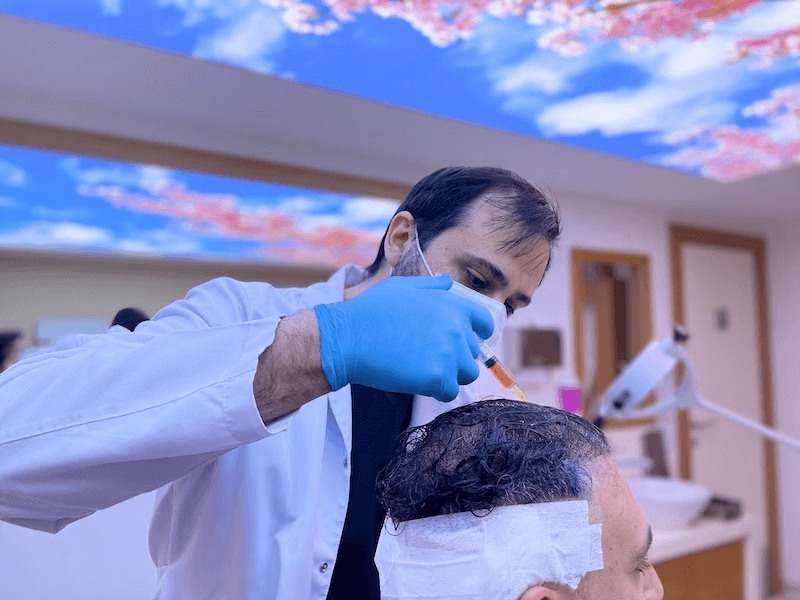
Pros of PRP therapy as a Finasteride alternative
- Minimally invasive: PRP treatments involve injections of the patient’s own plasma, making it a minimally invasive option for addressing hair loss.
- Natural approach: PRP harnesses the body’s own growth factors and healing abilities, which may be preferable to some patients over synthetic medications.
- Potential for hair growth: PRP treatments may stimulate hair growth and improve hair density in some patients, particularly when combined with other treatments.
- Limited side effects: Since PRP utilizes the patient’s own blood, side effects are generally mild and include temporary discomfort or swelling at the injection site.
Cons of PRP therapy as a Finasteride alternative
- Limited research: While some studies have shown positive results, more research is needed to establish the long-term effectiveness of PRP treatments for hair loss.
- Cost: PRP treatments can be expensive, and multiple sessions may be required to achieve desired results.
- Time commitment: PRP treatments typically require a series of sessions, which may be time-consuming for patients.
- Inconsistency: Results can vary among individuals, and some patients may not see significant improvement.
4- Laser Caps
Sometimes, patients prefer an option with less contact, which does not contain a chemical or a needle. Laser caps are one of those options that start to shine.
With a self-explanatory name, laser caps are wearable caps/hats with a layer of laser diodes on their inner surface. These laser diodes work by projecting light into your scalp. Therefore, they are typically considered the home-use version of Low-level-laser therapy due to their convenience and cheaper cost.
Although the principles for how they work look like a work of science fiction, their structure is relatively straightforward and effective. Each laser diode shoots a red light containing a high amount of photons to your scalp, which is then absorbed by your cells and converted into a form of energy that supports cell regeneration and hair growth. So, it doesn’t directly promote hair growth but strengthens the cells responsible for it.
According to its most famous publisher’s website, these caps must be used for 30 minutes daily for 6 to 12 months to create sustaining results. As for their effectiveness and side effects, they contain the same pros and cons that traditional laser therapy methods have:
Pros of laser caps as a Finasteride alternative
- Non-invasive treatment: Laser caps use low-level laser therapy (LLLT), providing a non-invasive option for addressing hair loss.
- FDA-cleared: Some laser cap devices have been cleared by the FDA, indicating their safety for hair loss treatment.
- Ease of use: Laser caps can be used at home, making them convenient and time-efficient for patients.
- Minimal side effects: LLLT typically has few side effects, which may include temporary scalp irritation or redness.
Cons of laser caps as a Finasteride alternative
- Limited effectiveness: The effectiveness of laser caps can vary among individuals, and some may not see significant improvement.
- Cost: High-quality laser caps can be expensive, and the long-term cost may be substantial.
- Time commitment: Laser caps require consistent use over an extended period, which may be time-consuming and inconvenient for some patients.
- Lack of robust research: While some studies show positive results, more research is needed to establish the long-term effectiveness of laser caps for hair loss.
5- Laser therapy / Low-level laser treatment
Unlike its recent invention, laser caps, the technology behind the laser therapy technique has an extensive background. Low-level laser therapy (LLLT) first appeared in the 1960s, thanks to the Hungarian physician Endre Mester.
As a test, Dr. Mester projected low-level lasers on shaved mice. And then noticed that these test subjects showed much faster hair growth with laser projection than those without it. Lastly, in 2007 low-level laser therapy gained approval as a safe treatment for pattern balding. Since then, this method has been adopted by many clinics due to its effectiveness in promoting hair growth.
Due to their effectiveness, traditional laser therapies are more costly than many other hair loss options. They are also considered much safer and do not directly engage with the patient’s body.
However, aside from its cost, you must come for several sessions a week for an extended period for this method to work.
Many patients still prefer this option despite its cost and the long time required to show results because it is very effective in battling hair loss and shows no significant side effects, according to studies.
Pros of LLLT as a Finasteride alternative
- Non-invasive treatment: LLLT is a non-invasive option for addressing hair loss, using red or near-infrared light to stimulate hair growth.
- FDA-cleared: Some LLLT devices, such as laser caps and combs, have been cleared by the FDA, indicating their safety for hair loss treatment.
- Ease of use: LLLT devices can be used at home, making them convenient and time-efficient for patients.
- Minimal side effects: LLLT typically has few side effects, which may include temporary scalp irritation or redness.
Cons of LLLT as a Finasteride alternative
- Limited effectiveness: The effectiveness of LLLT can vary among individuals, and some may not see significant improvement.
- Cost: High-quality LLLT devices can be expensive, and the long-term cost may be substantial.
- Time commitment: LLLT requires consistent use over an extended period, which may be time-consuming and inconvenient for some patients.
- Lack of robust research: While some studies show positive results, more research is needed to establish the long-term effectiveness of LLLT for hair loss.
6- Saw Palmetto
Saw palmetto is the most recent alternative method we have today for treating hair loss. Although Saw palmetto berries have been used in American folk medicine for several hundred years as an aphrodisiac and for treating prostate problems, their history in treating hair loss is pretty new.
But this method appears on our list today because of the discoveries made since the 1900s about its excellent effectiveness in treating male pattern baldness and benign prostatic hyperplasia.
The name of this medication belongs to its main natural ingredient, a flowering plant called saw palmetto. Saw palmetto plant works by blocking the conversion of testosterone into the DHT hormone (dihydrotestosterone, the primary hormone responsible for hair loss), precisely the same process as Finasteride.
Also, just like Finasteride, this method must be used continuously for a long time to show and maintain its benefits. And, as this medication is more pure and natural in its form, modern studies show little to no side effects whatsoever while demonstrating its effectiveness.
Furthermore, aside from its topical medication form, you can also consume this plant in the form of tea. However, this is where its downsides begin to appear. As this is a very pure form of hair loss medication, its dosage for being effective is incredibly high compared to Finasteride. Whether it is a food supplement or not, around 200 mg of its dose must be used several times a day.
As for its effectiveness, studies show that 38% of patients who took 320 mg of saw palmetto every day for two years showed improvement in their hair loss, compared to Finasteride’s effectiveness rate of 68%.
Pros of Saw Palmetto as a Finasteride alternative
- Natural alternative: Saw palmetto is a plant-derived supplement which may appeal to individuals seeking a natural alternative to synthetic medications.
- DHT inhibition: Saw palmetto is believed to inhibit the enzyme 5-alpha reductase, similar to finasteride, potentially reducing hair loss by blocking the conversion of testosterone to DHT.
- Fewer side effects: Saw palmetto typically has fewer side effects compared to finasteride, with reported side effects being generally mild, such as digestive issues or headaches.
Cons of Saw Palmetto as a Finasteride alternative
- Limited research: The effectiveness of saw palmetto for hair loss is not as well-established as finasteride, and more research is needed to confirm its efficacy and safety.
- Inconsistent dosing: The optimal dose of saw palmetto for hair loss is not well-defined, and the quality of supplements may vary between manufacturers.
- Less potent: Saw palmetto may be less potent than finasteride regarding DHT inhibition and overall effectiveness.
- Continuous usage: Similar to finasteride, saw palmetto needs to be taken consistently to maintain its effects; once stopped, hair loss may resume.
7- Stem Cell Micro-Graft Hair Transplant
Stem Cell micro-graft hair transplant is one of the latest innovations in the hair restoration industry.
The treatment is done with FDA-approved and CE-certified Regenera Activa AMT stem cell kits and centrifuge.
According to the study done in 2017, 23 weeks after the stem cell autologous micro-graft transplants, a 29% increase in hair density is observed in the treatment zone (compared to 1% in the control zone).
These stem cells are from human hair follicles.
Therefore, it is considered a very effective treatment by authorities for treating androgenetic alopecia and hair loss and is utilized by famous dermatologists and hair transplant specialists worldwide.
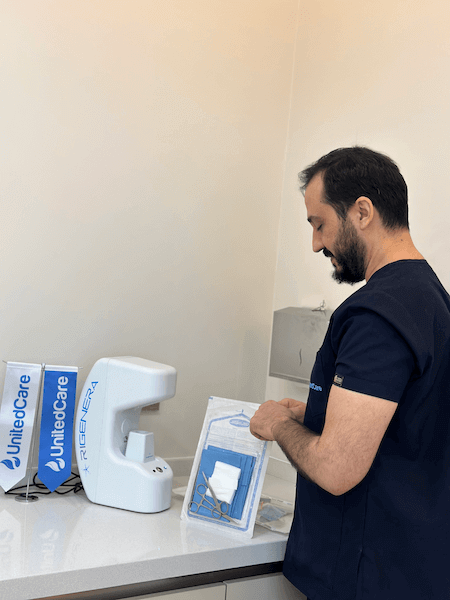
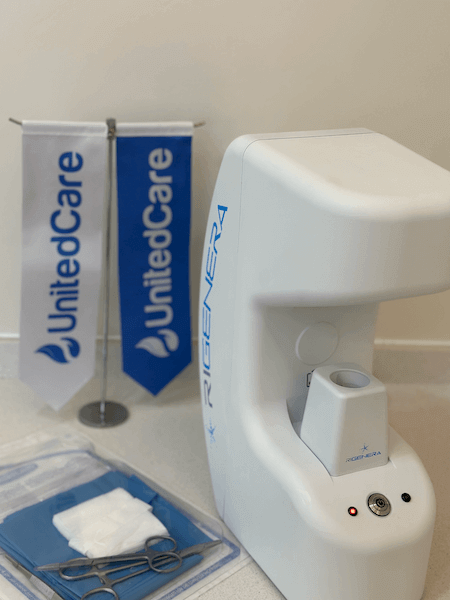
Pros of stem cell transplants as a Finasteride alternative
- Regenerative potential: Stem cell transplants harness the regenerative power of stem cells to potentially stimulate hair growth and address the root cause of hair loss.
- Long-lasting results: Stem cell transplants may provide long-lasting or even permanent results, unlike finasteride, which requires continuous usage.
- Natural appearance: As stem cell transplants aim to regenerate hair follicles, the resulting hair growth tends to have a natural appearance.
- Minimally invasive: While more invasive than medications, stem cell transplants are considered minimally invasive compared to traditional hair transplant surgeries.
Cons of stem cell transplants as a Finasteride alternative
- Limited availability: Stem cell treatments for hair loss are still in the early stages of research and development, making them less widely available.
- High cost: Stem cell transplants can be expensive, with costs potentially reaching tens of thousands of dollars.
- Lack of robust research: More research is needed to establish the long-term effectiveness and safety of stem cell transplants for hair loss.
- Variable results: The success of stem cell transplants can vary among individuals, and some patients may not see significant improvement.
Get a Stem Cell Hair Transplant at UnitedCare
Restore your natural look with UnitedCare‘s expert dermatologists:
8- Nourkrin Bioactive Proteoglycan
Even if FDA-approved Nourkrin seems like a drug, it is entirely drug-free and consists of natural ingredients.
After regular use for 12 months, almost 2500 over 3000 Nourkrin users reported that their hair density significantly improved.
It attacks the underlying cause of many types of hair loss by reducing Proteoglycan Follicular Atrophy and supporting normal and healthy hair growth. It normalizes and balances the hair growth cycle.
Even if it is unknown by many doctors, it has been on the shelves for more than 25 years and has evolved significantly.
What is best about Nourkrin is that it has no reported side effects. This is mainly because of its natural ingredients.
Please note when purchasing on the advice of your doctor: There are two versions of this product: Female Nourkrin and Male Nourkrin, each formulated differently to treat hair loss more effectively.
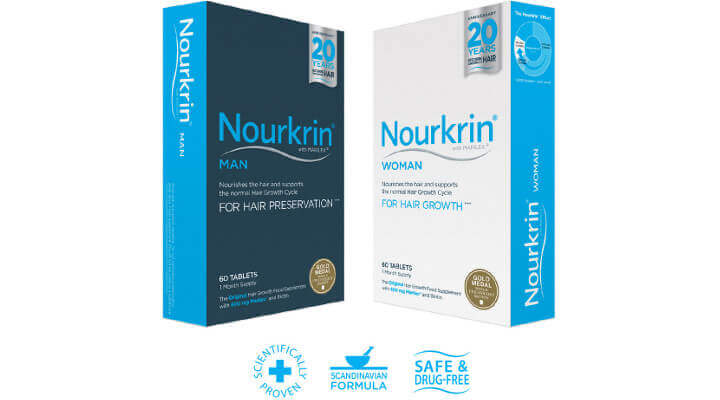
Pros of Nourkrin as a Finasteride alternative
- Natural ingredients: Nourkrin products contain natural ingredients, including bioactive proteoglycans, which may appeal to individuals seeking alternative treatments.
- Clinically tested: Nourkrin’s formula has undergone clinical testing and is reportedly effective for some users in improving hair growth.
Cons of Nourkrin as a Finasteride alternative
- Limited research: More research is needed to establish the long-term effectiveness and safety of Nourkrin Bioactive Proteoglycan for hair loss.
- Cost: Nourkrin products can be expensive, especially if used for long periods.
9- Procapil
Continuing from the list of medications that contain natural ingredients, Procapil is another noteworthy example.
It is a unique mixture of various natural ingredients in a single medicine specially produced to help with hair loss.
This medication also works like Finasteride as it blocks the production of the DHT hormone to stop hair loss. As for its usage, this medication appears in two different forms: Either as a topical solution for male pattern baldness or as an oral that you can take daily, which will require your continuous dedication.
As for its effectiveness, a study shows that the objective success rate for preventing hair loss and subjective satisfaction rate from patients was much higher than other medical options such as Minoxidil (by almost two times).
Pros of Procapil as a Finasteride alternative
- Natural ingredients: Procapil is a natural, plant-based complex that combines biotinyl-GHK, apigenin, and oleanolic acid, which may be appealing to those seeking alternative treatments.
- Targets hair loss causes: Procapil aims to address multiple causes of hair loss, including poor scalp circulation, follicle aging, and DHT production.
Cons of Procapil as a Finasteride alternative
- Limited research: The effectiveness of Procapil for hair loss is not as well-established as finasteride, and more research is needed to confirm its efficacy and safety.
- Continuous usage: Similar to finasteride, Procapil must be used consistently to maintain its effects; once stopped, hair loss may resume.
10- Prostaglandin
Prostaglandin is a new, clinically proven method that takes its name from the molecules used in the process.
Prostaglandins are naturally occurring molecules found in almost every cell in our bodies, and they can affect many conditions, including hair loss.
They are produced by the adipose tissues, the same cells responsible for creating new hairs. In other words, prostaglandins work by boosting your body to make more, better, and thicker hair.
These medications typically come in an injection form, where they are first injected into your scalp before being absorbed into your bloodstream. They then cause your body to start producing more of the beneficial prostaglandin cells naturally through enzymes, boosting your body’s existing production cycle.
Studies about its effectiveness show that this medication dramatically speeds up the regeneration process of hair follicles, which in turn causes your hair to grow faster.
Pros of Prostaglandin as a Finasteride alternative
Potential for hair growth: Prostaglandin analogs, such as bimatoprost and latanoprost, have shown potential for stimulating hair growth in some studies.
Cons of Prostaglandin as a Finasteride alternative
- Off-label use: Prostaglandin analogs are primarily used for glaucoma treatment, and their use for hair loss is considered off-label.
- Limited research: More research is needed to establish the long-term effectiveness and safety of prostaglandin for hair loss.
- Side effects: Prostaglandin analogs can cause side effects such as eye irritation, redness, and changes in eyelid color or eyelash growth.
11- Viviscal
Contrary to its alternatives for treating hair loss in medical terms, Viviscal works without directly interacting with your DHT hormones.
That is precisely why this drug is called a supplement drug.
It is a dietary supplement medication for hair growth. The way it works is by supporting your existing hair with nutritious proteins. Typically, your hair constantly renews itself over time by dropping your old hair and regrowing new it. When Viviscal comes into play, it brings rich amounts of protein into your strands, encouraging new ones to grow.
As seen in multiple studies that are even accessible on its website, Viviscal is an excellent tool for hair loss, especially if an increase in hair diameter and thickness is the primary objective. Although it cannot get approval from the FDA for not being a drug, its clinically proven factors make this medication “fitting” for the FDA requirements.
This medication comes in the form of either a liquid or a powder. And as the former version contains many high-quality ingredients, I heavily suggest getting the liquid version to get the most benefit possible from this method.
Pros of Viviscal as a Finasteride alternative
- Natural ingredients: Viviscal is a marine-based, drug-free supplement containing AminoMar C™, a proprietary blend of proteins, vitamins, and minerals.
- Clinically tested: Viviscal has undergone clinical testing and is reportedly effective for some users in improving hair growth.
Cons of Viviscal as a Finasteride alternative
- Limited research: More research is needed to establish the long-term effectiveness and safety of Viviscal for hair loss.
- Cost: Viviscal products can be expensive, especially if used over a long period.
- Allergen concerns: Viviscal contains fish and shellfish-derived ingredients, which may be a concern for individuals with allergies.
Overall, all the methods in this list are famous, clinically proven, and noteworthy alternatives to Finasteride for treating hair loss.
However, Finasteride is also very commonly used for being a medication against BPH, so let’s check what options you have for that:
Finasteride Alternatives for BPH
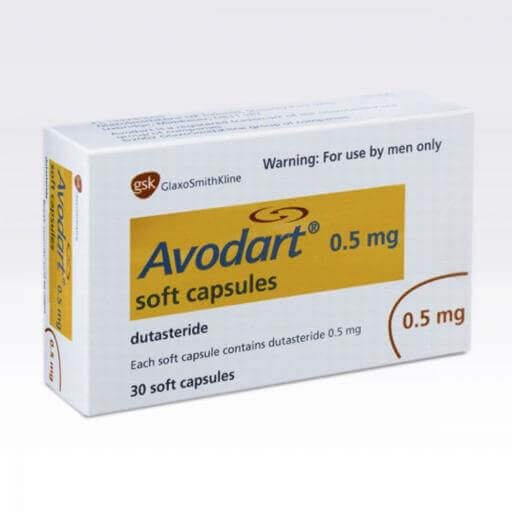
Aside from treating hair loss, Finasteride’s second most attractive use is treating benign prostatic hyperplasia (BPH). As the treatment for BPH requires a much higher dose of Finasteride to be consumed daily, this dose of Finasteride appears under a different brand name: Proscar.
This amount of Finasteride is solely for treating patients with BPH due to its 5 mg dosage. So, Finasteride’s clinically proven potential alternatives for treating BPH are mainly medications that are either solely used for this purpose or for the most advanced cases of hair loss where these medications require supplements.
Here are the clinically proven medical alternatives to Proscar Finasteride:
12- Avodart Dutasteride
Sold under the brand name Avodart (among many others), Dutasteride is undoubtedly one of the first medications to appear on the front as an alternative to Finasteride for treating BPH.
To add to its fame as another proof of its effectiveness, Dutasteride is the fastest technique to gain approval after its first discovery in our list. It was patented in 1996 to be described in the scientific literature just a year later in 1997. And just four years later, it was approved by the FDA for treating benign prostatic hyperplasia in November 2001.
Aside from being approved by the FDA, like Finasteride, this medication is a valid clinical choice for dealing with BPH and follows the same working principle. It treats male pattern baldness by blocking the conversion of testosterone to the DHT hormone. As studies show, the difference is that Dutasteride (90%) is more efficient than Finasteride (70%) at blocking the DHT hormone from ever being created.
However, the downside of Dutasteride is that this medication’s potential side effects are more common and severe than Finasteride’s, and some of them are potentially entirely irreversible. These side effects include but are not limited to:
- Impotence
- Decreased libido
- Ejaculation disorder
- Pain in testicles
Therefore, as I always do, I suggest you talk to your doctor before deciding on this treatment and inform them, especially if you have an existing condition.
13- Tamsulosin (Flomax)
Usually sold under its famous brand name Flomax, Tamsulosin is one of the most commonly prescribed drugs for men to treat BPH.
The FDA approves this drug, and its dosage appears as a 0.4 mg capsule for daily intake to treat symptoms of BPH.
This medicine works by relaxing the bladder, neck muscles, and the muscle of the prostate gland itself to allow you to urinate more freely.
In its comparison to Finasteride and other alternatives, what makes this method appealing, despite having a lower rate of success rates, is its sustainability. According to a study, Tamsulosin can maintain its benefits without ever lowering effectivity for up to 6 years if used continuously.
However, as the effectivity rate of the method is lower than other choices, this medication usually appears as a supplement drug that you can use alongside other choices such as Minoxidil or Dutasteride.
14- Tadalafil (Cialis)
This medication is a somewhat newer one compared to the others.
Usually appearing under the brand Cialis, Tadalafil got its approval from the FDA in 2003. Aside from its early origin, another feature that might not be so appealing is that it contains a heavy 5 mg tablet dose that you must take orally.
As for how it works, it is the same with Finasteride.
It works by inhibiting the production of DHT hormone, which causes hair loss and enlargement of the prostate.
However, the critical part of taking notice is that Tadalafil has two distinguishing positive sides to compensate. According to a study, you can consume Tadalafil once per day continuously or on-demand because its effects quickly show themselves within the body.
And another valuable benefit of this medication is that, according to another study, it does contain the usual side effects that other DHT-inhibiting drugs have, such as Finasteride.
To sum up, Finasteride contains a high number of alternatives with different sets of benefits and downsides. However, all the methods I have gone through are medical options.
In other words, they are chemicals modified in a lab. Thus, they usually come with specific side effects, regardless of how rare they might seem. That is why some patients see these methods as no different than Finasteride and instead just look for natural alternatives.
So, here are your best natural alternatives for Finasteride that are proven to work and are approved by clinics for continuous usage:
Natural Finasteride Alternatives 🍀
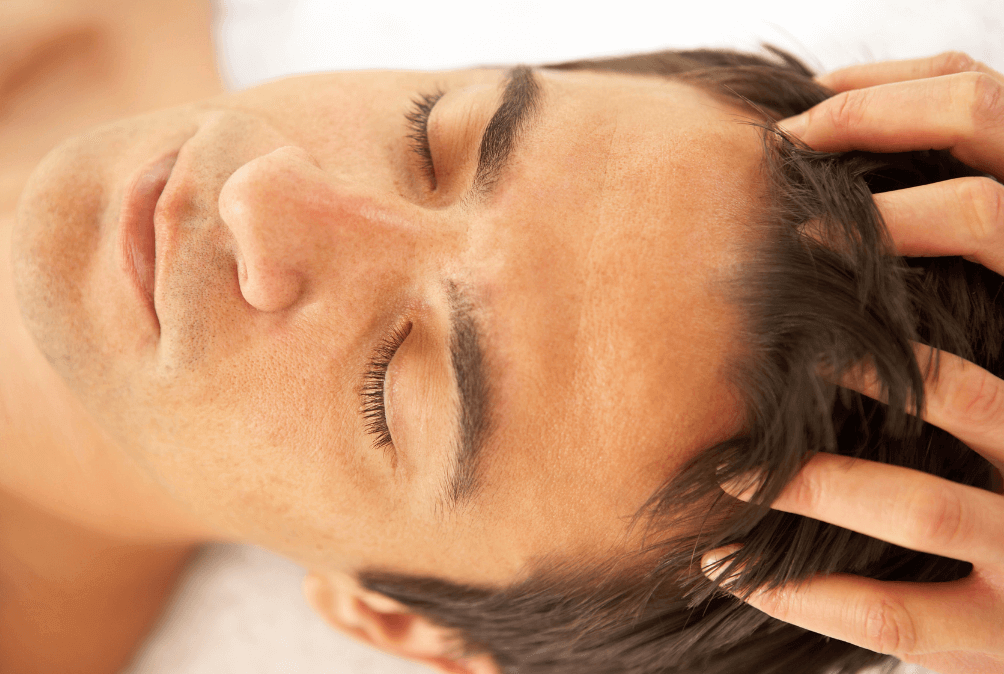
15- Aloe Vera
⚠️ One thing I should mention first is that Aloe Vera, like many other natural alternative methods, can trigger your sensitivity or allergy to the medication (due to the vast number of acids in it) if you have one. As always, our motto is that you should advise your doctor about your medical history beforehand.
Studies show that Aloe Vera is a famous plant with many beneficial acids, enzymes, minerals, and vitamins that can positively affect your hair’s health.
The beneficial compounds in Aloe Vera bring out this natural medication’s effectiveness in two ways:
- Vitamins and acids in aloe vera feed your scalp to enhance your hair’s health for regrowing faster, thicker, and more resistant.
- Other ingredients, such as enzymes and minerals, help you by preventing you from having an oily scalp and reducing the inflammation in your scalp. These are known reasons for slowing down and obstructing hair loss.
Due to these active ingredients, this natural remedy has been a trusted option for hundreds of years. To explain how to use it, you can apply aloe vera gel directly on your scalp by massaging it gently twice a day for about 10 minutes.
💡 The last thing to remember about this medication (and every other one in this final part of the list as natural remedies) is that due to its less chemically-enhanced background, its effectivity is less than other medical alternatives such as Finasteride.
Therefore, they usually appear as supportive medications that you should use alongside different methods for better results.
16- Scalp Massages
Scalp massages are one of the most popular and proven methods to stimulate hair regrowth.
In support of your hair’s regrowth, this remedy increases your scalp’s health in two ways:
- Scalp massages stretch the cells of hair follicles and make them thicker, resulting in thicker hair produced from your hair follicles. According to a study, doing scalp massages for 4 minutes per day for 24 weeks increases hair thickness by %10.
- Applying scalp massages regularly drastically improves the overall blood circulation throughout your scalp, boosting your hair growth. A study showed that hair loss stabilization and increased regrowth were reported in 69% of 340 patients who have done scalp massages of 10 to 20 minutes twice a day for six months.
This method is quite simple; you can gently massage your scalp using a massage brush or hands. Applying light pressure to the skin for 5 to 10 minutes daily should be enough. Just ensure you thoroughly wash your hair, hands, or brush beforehand.
17- Derma Roller or Derma Stamps
The two only differ in shape, design, and mechanisms but do the same thing: Damaging skin and causing very micro-injuries without breaking the integrity of the skin to stimulate collagen, elastin fiber production, and vascularization.
⚠️ If a skin zone is bald for a long time, skin quality reduces, and atrophy occurs. Vascularization and nutritient/oxygen consumption in that zone significantly reduces. The graft survival rate may significantly reduce if a HAIR TRANSPLANT is done on an atrophied zone.
That is why I always recommend hair transplant candidates be examined by a dermatologist 4-6 weeks before the hair restoration surgery.
PS: Vascularization is the process of growing blood vessels into a tissue to improve oxygen and nutrient supply.
Derma roller and derma stamps increase blood flow and vascularization, enabling hair follicles to thrive and normalize hair growth cycles. Therefore, hair thickness and density are increased after regular application of roller and stamps for a while.
18- Avocado oil
Many famous and trusted natural remedies for treating hair loss are natural oils. Because usually, their rich ingredients contain a high amount of effective compounds, enough to gather the attention of researchers.
And most of the time, they are applied with the support of scalp massages, which also heavily promote your hair growth.
This method’s history of trusted use goes back to the Aztecs’ time for promoting hair growth and preventing hair loss. That is because Avocado oil is rich in vitamins such as A, B1, B2, D, and E. All these vitamins greatly help your body nourish your hair’s roots.
It also contains a good amount of very beneficial acids, biotin, and antioxidants.
These are excellent sources for strengthening your follicles’ health and reducing hair loss.
To benefit from its positive effects, you can apply half a teaspoon of Avocado oil directly on your scalp three times a week before washing it off with shampoo after approximately 10 minutes. Recent studies also show that aside from treating the setbacks of natural hair loss, this method is also helpful in treating damages to your hair caused by outside sources.
19- Geranium oil
Geranium oil is another home remedy used for many decades to stimulate hair growth in balding patients. However, its clinically proven background is pretty new.
Despite that, these studies still show successful results.
According to a study made in 2017, its effectiveness at significantly enhancing hair regrowth and preventing hair loss is comparable to that of Minoxidil.
This medication regulates the amount of dryness on your scalp and around your hair follicles by using its beneficial chemical compounds. Therefore, using them regularly allows your hair follicles to work healthier.
To benefit from it, you can apply Geranium oil directly on your scalp 3 or 4 times a week for about 5 minutes before washing it off with shampoo.
20- Rosemary oil
The oil in this herb is a widespread, universally known beneficial remedy that has been used for many different conditions over the years, including MPB.
This remedy’s beneficial effects come from affecting the insides of your scalp.
By using the ingredients in it, such as specific acidic chemicals like Carnosic acid, Rosemary oil increases the blood flow around your head. As a result, your hair follicles get more oxygen and nutrients pumped into them. And when your hair follicles absorb more nutrients from your bloodstream into their cells, your hair starts growing healthier.
Aside from taking the established place of Rosemary essential oil in different cultures worldwide as evidence, it also has clinical studies showing its effectiveness.
According to an interesting study, Rosemary oil was as effective as Minoxidil in treating hair loss. In this research group, the rate of increase in hair count was the same for both groups using Minoxidil and Rosemary oil at the end of the study.
More importantly, in contrast to and unlike Minoxidil, Rosemary oil has almost no side effects, such as scalp sensitivities or irritations.
You can apply this remedy on your scalp 3 to 4 times a week for about 10 minutes after showering.
21- Fatty Acids
The most recognizable mutual part of natural remedies for hair loss is that the working principle for almost all of them is strengthening your hair follicles or scalp to increase their health, reflecting positively on your hair growth.
And when I talk about nutritious natural medications for hair growth, the most irreplaceable and important one is, without a doubt, fatty acids.
Fatty acids usually refer to two essential nutrients: Omega-3 (found in fish) and Omega-6 (found in most nuts, seeds, and oils like sunflower or canola). Both of these acids are proven to help induce hair growth by studies showing that fatty acids increase hair density in patients by 62%.
These beneficial nutrients create a protective barrier on your scalp’s skin and prevent dryness or itchiness. As a result, your hair follicles get the chance to work healthier without being affected by outside resources or harmful chemicals such as DHT.
You can gain the benefits of fatty acids in different ways:
- You can apply them on your scalp 3 to 5 times a week for about 10 minutes.
- You can simply eat them rather than putting them on your scalp, which allows your body to absorb these nutrients better. So, you can instead take fatty acid supplements such as daily capsules to benefit from these as much as possible.
22- Onion extract (as shampoo)
⚠️ Reminder that raw onion juice is very acidic and can harm your scalp and hair. Therefore, I suggest you use products that contain this natural ingredient instead.
Thanks to its easy access and practical use, onion extract has been among the most used natural methods for treating hair loss since ancient times. It is a reliable remedy because onion contains many good properties that directly affect your hair’s health, such as amino acids, vitamins, enzymes, magnesium, and even Keratin. By starting with Keratin, all these ingredients are so effective that they have their products, and onion extract contains them all at once under its juice which heavily promotes hair growth, as supported by studies.
Although studies show that onion extract thoroughly supports hair density and increases hair growth, using it directly on your scalp (instead of consuming it) is heavily dangerous and harmful due to its acidic nature. Therefore, I suggest certain products, such as onion extract-containing shampoo. According to a study, this shampoo product nourishes hair follicles, promotes hair growth, and prevents dryness by moisturizing the scalp.
If you plan on using this shampoo, the same study suggests applying it to your scalp and keeping it there for 5 minutes before washing it off for the best results.
23- Adapting to a better lifestyle
In the daily life of our modern era, one common mistake we make without even noticing is ignoring to be careful with our diet and skipping proper exercise. Our lives are so crowded with responsibilities and constant rushing that we hardly show any effort to spare time for them. Consequently, we look for shortcuts such as pills, medications, and natural remedies that we can just take on the go.
So, when we take these into notice, the most natural and impactful alternative method for any type of clinical medication is ensuring that you never need them at all by maintaining a stress-free lifestyle with a balanced diet and a proper exercise routine.
The three most common external reasons for our scalp’s losing health over time are:
- Worsening our eating habits by consuming fast food instead of healthy meals, and sometimes even skipping some meals altogether. Our diet should contain a healthy and wealthy amount of carbohydrates and proteins that feed our scalp with nutrients.
- The increasing number of practical technologies such as computers, TVs, or smartphones removed most of our reasons to just go out for a walk once in a while. Remember that just like the necessary nutrients, our scalps also need fresh oxygen and sunlight, so it is healthy to go for a run and sweat to keep the machine working.
- High-stress levels appear in either mental forms such as improper sleep routines or more physical ways such as oxidative stress. Either way, they promote further hair loss and require an immediate lifestyle change.
As we ignore the need to increase our blood circulation and get used to consuming unhealthy processed foods filled with high fat, our bodies start losing their balance. And as we lose balance, dozens of causes for hair loss emerge:
- Consuming too many Minerals and Vitamins can become toxic: According to a study, Vitamin A, which is crucial for the cellular growth of hair follicles, was found to be harmful and toxic if consumed too much, which can cause hair loss.
- Consuming too little: Alternatively, an orderly diet that controls the nutrients allows you to avoid opposite factors such as iron deficiency. According to another study, lacking necessary nutrients, such as the case of iron deficiency, can cause apparent hair loss.
- Obesity: As our bodies get filled with high amounts of fat at the level of becoming obese, our metabolism gets weaker. As a result, specific syndromes and diseases such as metabolic syndrome or diabetes become apparent. And as the studies suggest, our bodies become more susceptible to hair loss, not only at obesity levels but even on merely high-fat levels.
- Sugary products: The same study shows that the direct cause of metabolic syndrome can also be the high level of sugar (over 100 mg) in the bloodstream, as insulin within the sugar stimulates the process of hair loss. So, avoiding sugary products in itself is a solution.
Ultimately, not regularly following your diet and continuous exercise creates so many harmful effects on your hair’s health that it becomes difficult to cover up with medications or supplements alone. Therefore, I suggest you consider the benefits of diet and exercise.
➡️ There are many benefits of a healthy diet. Avoiding nutrition deficiencies or extreme levels that create toxicity and trigger hair loss are among the few obvious ones I have mentioned. The critical part, however, should be the method you use for picking the proper diet. In 21st-century medicine, the Mediterranean diet is one effective technique I advise our patients. According to a study, it is a comprehensive diet rich in phytochemicals that consist of raw vegetables and fresh herbs, all of which highly contribute to its effectiveness in reducing the risk of hair loss. In this diet, you should try to consume raw vegetables and fresh herbs at least three times a week, in the form of salads, for example, to see the results of this diet. Also, increasing the number of proteins you intake can positively affect your hair’s health as they are the building blocks of its roots.
➡️ The most apparent benefit of exercising is avoiding low blood circulation in your scalp. Movement and stimulation with exercise increase the amount of blood circulation in your scalp, which turns into more oxygen and nutrition flow going to your hair follicles for the benefit of healthy hair regrowth. Furthermore, it is proven that physical stress with exercise can significantly reduce mental stress as it gives your body and mental state a chance to release tension.
➡️ Speaking of stress, that is another reason entirely that you can avoid with an orderly lifestyle to prevent hair loss. According to a study, researchers have found a direct link between hair loss and stress levels, as high amounts of continuous pressure from non-released stress increase hair loss. So, regular exercise allows you to minimize your mental stress and protects your hair’s health in the long term. And similarly, managing any type of stress levels altogether also prevents you from having dangerous examples such as a lack of sleep or physical cases such as oxidative stress. As these are connected to triggering hair loss, according to studies, your lifestyle will be the direct factor in deciding whether your hair loss continues or ends with shining hair appearing instead.
I know that asking you to completely change your habits and adapt to a new, healthier style is significant. It is not easy to make changes in a single day.
Therefore, I suggest making small changes over time, such as trying to sort your sleep schedule if you suffer from a lack of sleep, as it can also directly affect your hair’s health.
When you see the benefits appearing over time, you can continue making minor changes to maintain this lifestyle and improve your hair’s health.
So, what should you choose?
Honestly, there is no definitive answer to what could be the best alternative to Finasteride.
In every sense possible, your body and your hair are unique. If you think you have a hair loss problem, you should consult a dermatologist as soon as you can to ensure you stop it before the damage is irreversible.
And that is why I’m here.
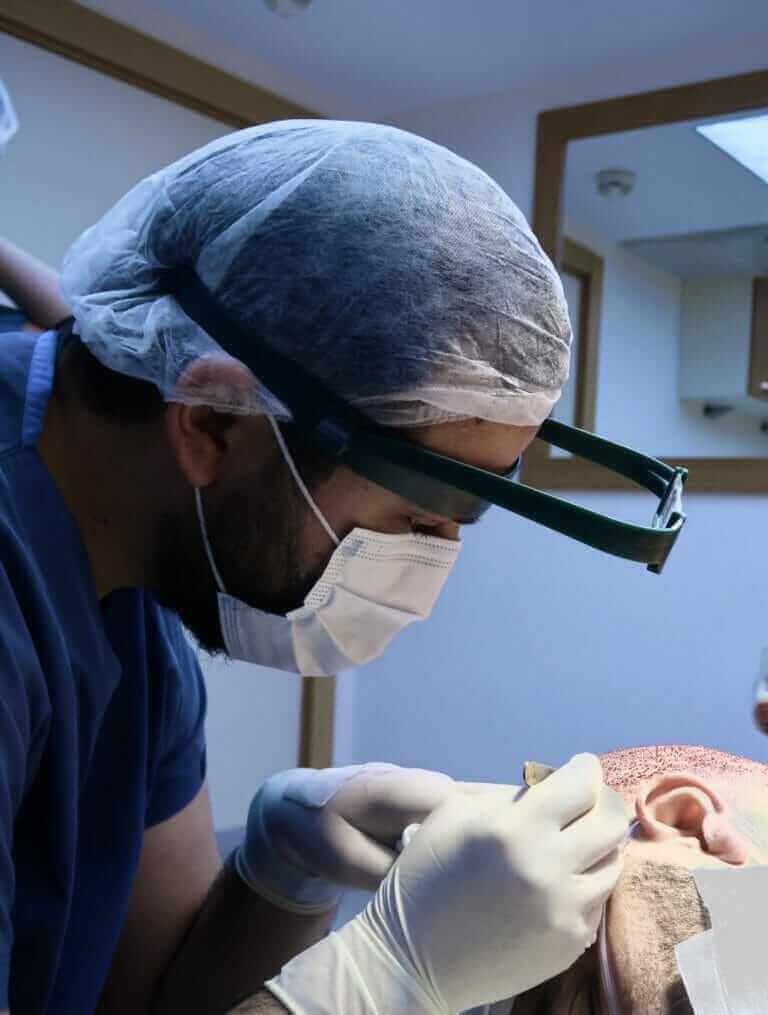
At UnitedCare, I first begin our treatment process by offering you a one-on-one consultation to find the best-suited option together. After you have decided on a method, I begin the treatment with the utmost attention.
But most importantly, I stay in contact with my patients even long after the treatment has already finished ensuring that the benefits of the medication stay intact. And so that I can easily reach out to you in case you have any concerns.
Regardless of which method you choose, one policy in our clinic stays the same. I value creating a balance between your comfort and your health.
In short, I offer to accompany you down the road if you have any remaining concerns or questions about deciding on a method.
Ready to begin the journey? Click here to start the first step:
Ensure success with Finasteride and more of our suggested supplements.
Restore your natural look with UnitedCare‘s expert dermatologists:
Frequently Asked Questions (FAQs)
Is there a substitute for Finasteride?
Not exactly. There are various options in our modern age, even many clinically approved ones, that can act as an alternative to Finasteride for dealing with hair loss and benign prostatic hyperplasia in medical or natural forms. But there is not an exact substitute for Finasteride as options are lacking in either their effectiveness, the rareness of side effects, or affordability compared to Finasteride. That is why some medications are mixed and used to gain Finasteride’s full benefits. On the other hand, I suggest that you use Finasteride alongside these methods for better, sustainable results.
What works better than Finasteride?
No definitive medication is ultimately better than Finasteride or could work as a complete substitute. Consequently, Finasteride stands out as one of the most popular, reliable, and potent medications in our modern age for dealing with hair loss. Because every alternative is simply lacking in one point, some other methods can have a slightly more successful rate, some can be more affordable, and some can have fewer or no side effects. But all these methods show less capability in other parts when compared. That is why no choice is a definite one that works better than Finasteride. I simply have some practical alternatives for covering some of its benefits.
Is saw palmetto as effective as Finasteride?
Studies show that 38% of patients who took 320 mg of saw palmetto every day for two years showed improvement in their hair loss, compared to Finasteride’s effectiveness rate of 68%. It means that in direct comparison, saw palmetto appears to be less effective compared to Finasteride. However, you should be aware that saw palmetto increases its effectiveness with increasing doses. And also, unlike Finasteride, it shows no particular side effects whatsoever, which is why it appears as a new, robust alternative to Finasteride for treating hair loss.
